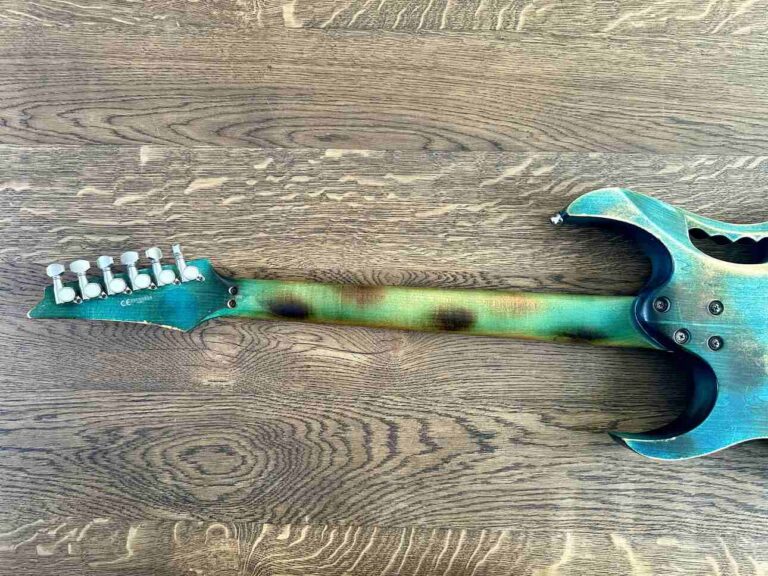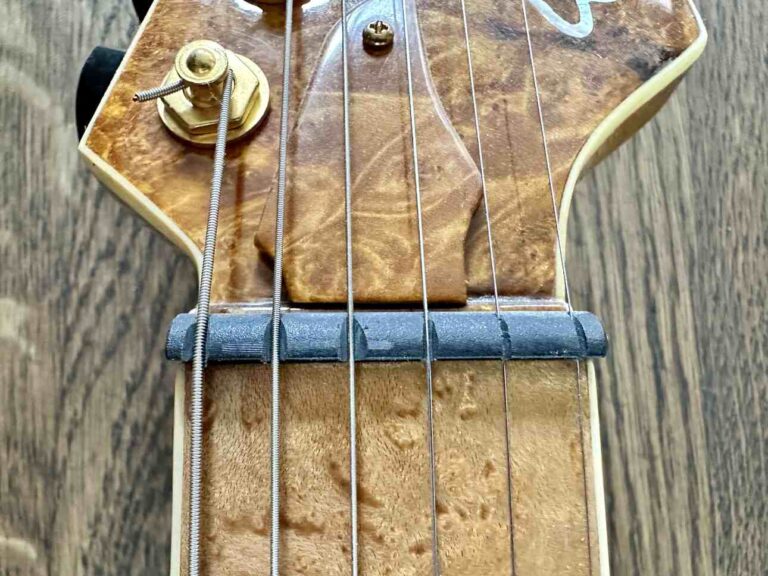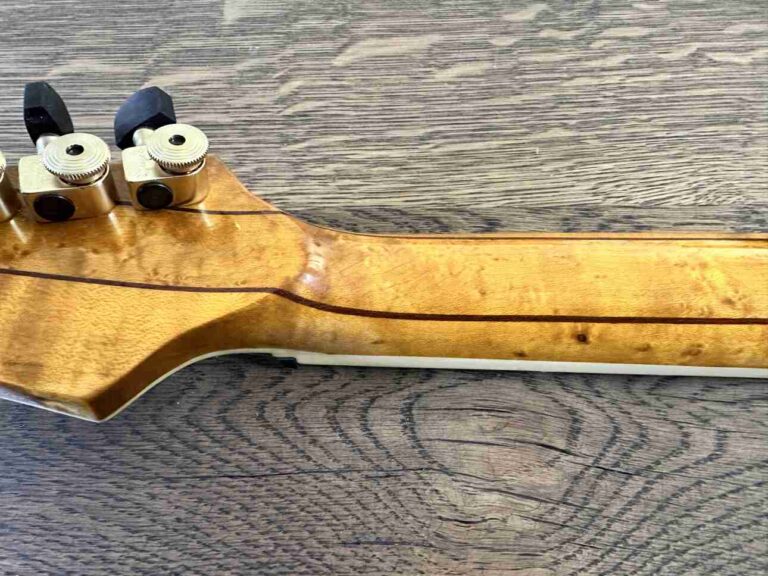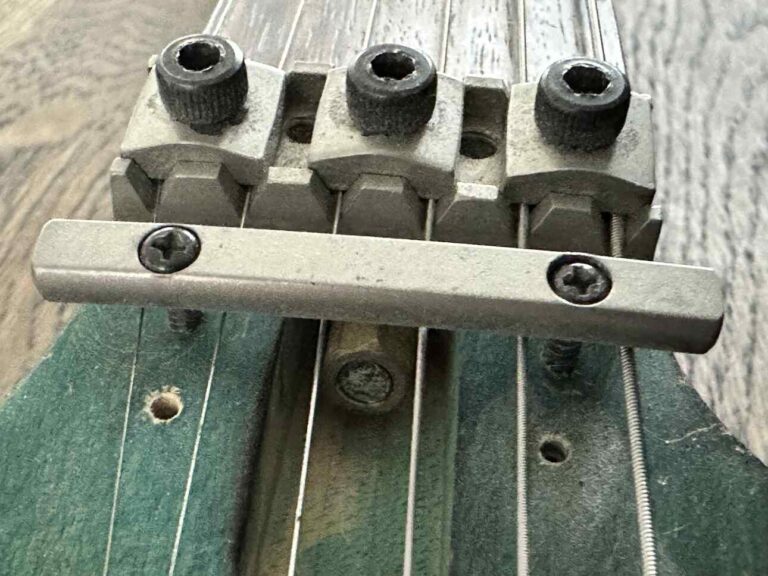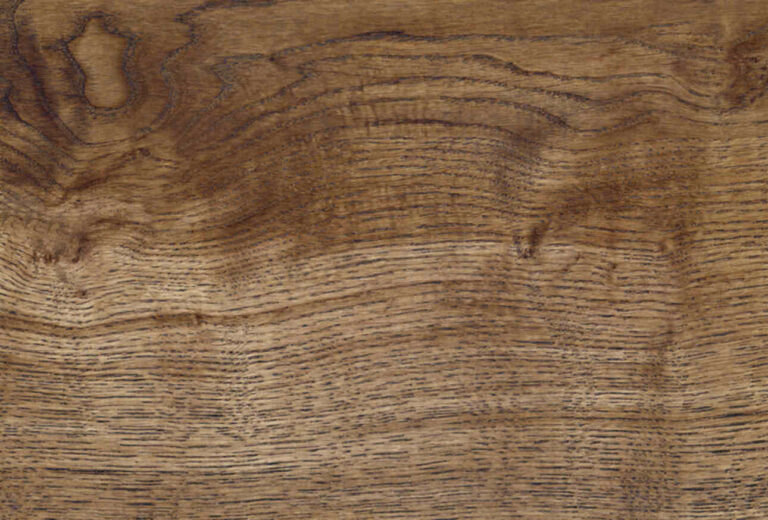Are Electric Guitar Necks Interchangeable? Guide to Compatibility
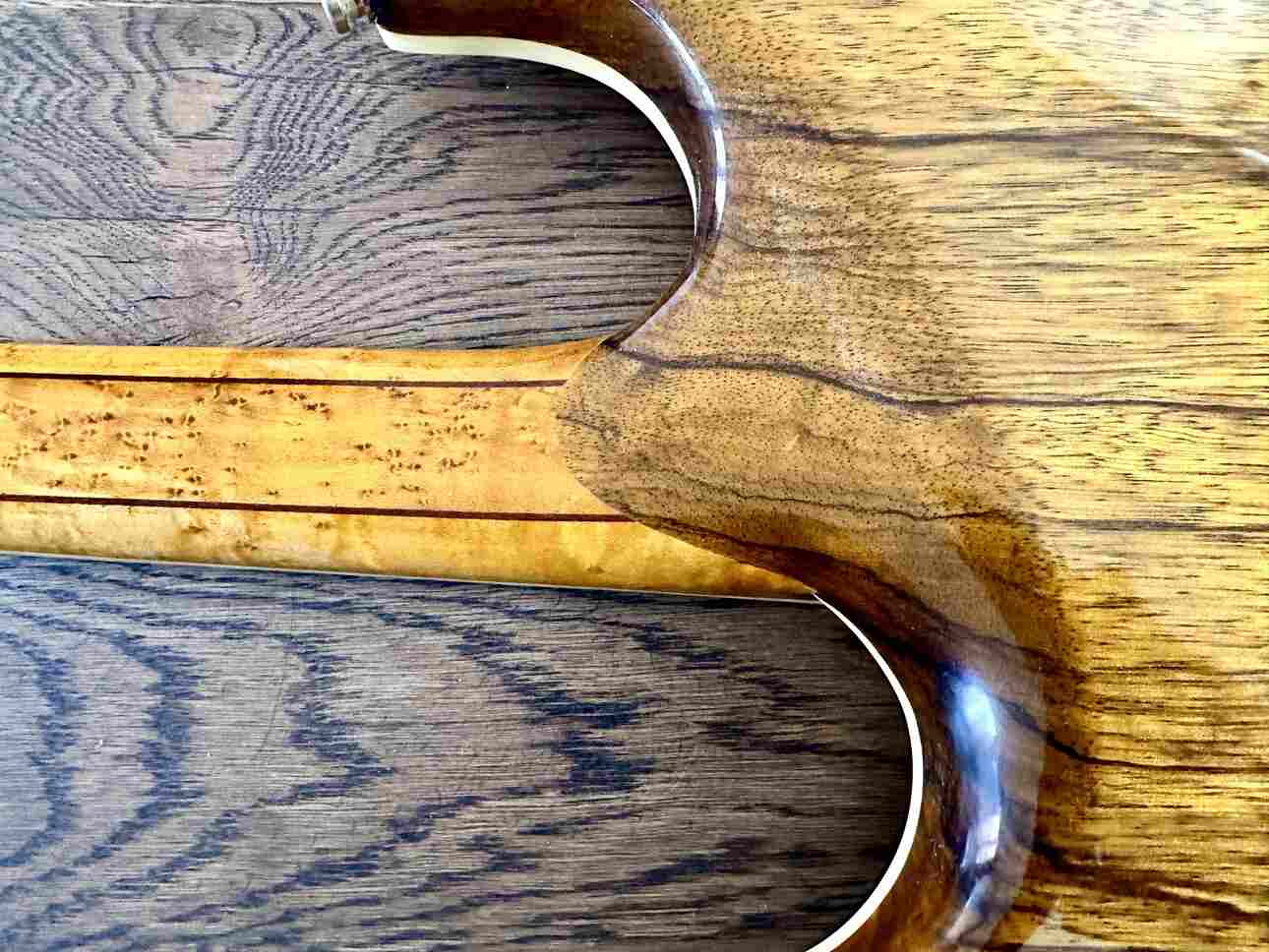
Swapping out guitar necks is possible but hinges on a few critical elements. This has to do with the build of the neck and body, how well they fit together, and their mutual compatibility. The good news is that electric guitar necks can be replaced or exchanged in many instances.
Swapping out an electric guitar neck isn’t like changing socks; there’s more to it.
First off, what’s holding the neck to the body? If it’s bolted on, you’re in luck – that’s like Lego for guitarists. Set necks? That’s a different kettle of fish; they’re glued in. Swapping those is like exchanging a baked-in chocolate chip from your cookie.
Don’t forget to measure twice. Get the size wrong, and you’ll have a neck swimming in space or refusing to budge into place.
The stuff it’s made from matters, too; mixing mahogany with maple is like wearing stripes with plaid – only sometimes the best look.
But here’s the kicker: a new neck can make your guitar feel like a whole different beast. Especially when you want it replaced with a fretless neck. It might throw your shredding off for a loop until you two get acquainted.
Let’s dive in!
Key Takeaways
- Electric guitar necks can be replaced or swapped depending on construction, fit, and compatibility. There are replacement necks on the market;
- Changes to the guitar neck can impact playability, and understanding neck construction is essential;
- Be prepared to troubleshoot potential issues after a neck swap to ensure smooth performance and stability.
Basics of Electric Guitar Neck Interchangeability
Factors Determining Neck Compatibility
Thinking about swapping your electric guitar neck? You’ve got to line up a few ducks first. Scale length is a biggie – it’s the backbone of how your guitar feels and bends those notes. Match the new neck’s scale length with the old one to keep your axe singing right.
Next up, size up the neck pocket. No two guitars are cut from the same cloth here, so measure up to make sure your new neck isn’t left out in the cold.
Don’t forget the bolts. A mismatch in the bolt pattern is like trying to fit a square peg in a round hole. And give a nod to the neck radius. It’s all about how your hand and the neck get along; you want that to be a smooth relationship.
So, grab your ruler and thinking cap, and make sure you’re not trying to fit a round neck in a square pocket.
Types of Guitar Necks
Electric guitar necks are like the flavors of ice cream – there’s a variety for everyone. Here’s the scoop on the three main types:
- Bolt-on Neck: These are the DIY dream. Held in place with screws or bolts, they’re a breeze to swap out. Think of the Fender Stratocaster or Telecaster—classic examples of guitars that rock the bolt-on neck;
- Set Neck: These necks are stuck on with glue and a firm handshake, making them a pickle to replace. It’s not mission impossible, but you’ll need some serious skills and elbow grease. The Gibson Les Paul and SG are the rock stars of the set-neck world;
- Neck-through: Now, these are the big kahunas. The neck stretches from the headstock to the strap button, all in one piece. Want to swap it? You might as well build a new guitar. But hey, they’re solid. B.C. Rich Warlock and Jackson Soloist fans know what I’m talking about.
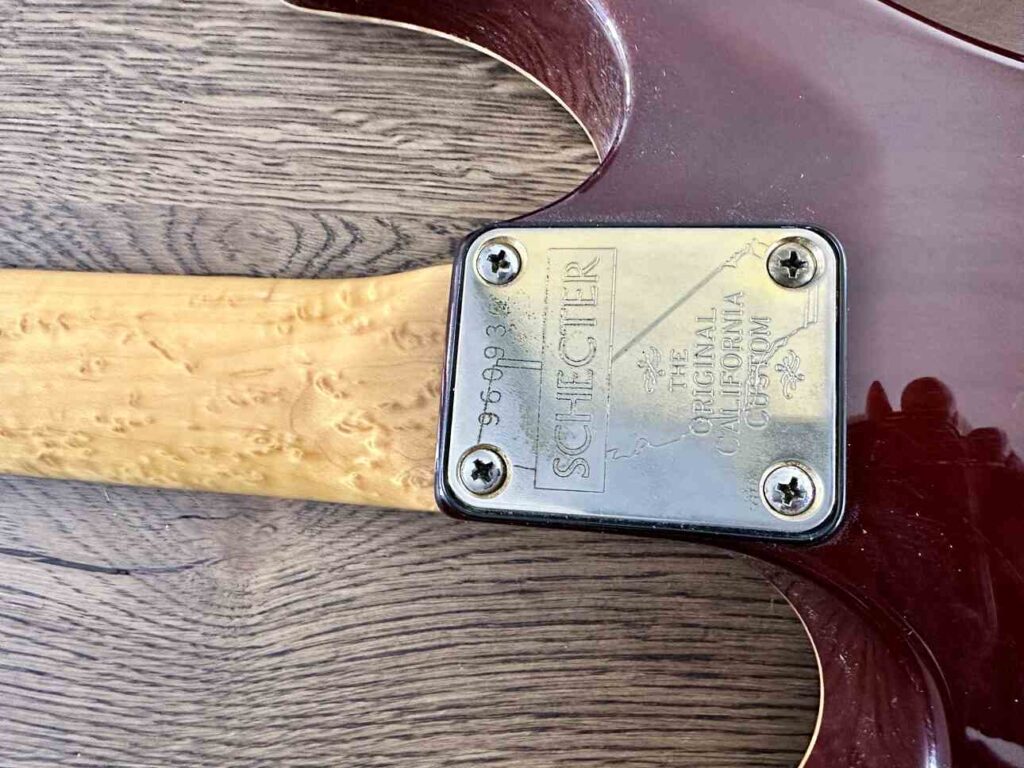
Understanding Guitar Neck Construction
Neck Shapes and Profiles
Chatting about electric guitar necks is like exploring the different grips of a baseball bat – they can really change the game. The neck’s shape is like a handshake with your guitar, and it’s got a lot to say about how cozy you two get;
- C-shape: This one’s the friendly neighbor of neck profiles. It’s rounded, easy to get along with, and sits in your hand like it was made for. Most folks find it pretty comfy;
- U-shape: Got hands like a basketball player? The U-shape has got your back with a bit more meat to grab onto. It’s like the sturdy handle of a trusty axe;
- V-shape: This one’s like the odd sock in the drawer. It’s not for everyone, but if it fits, it fits well. Some folks swear by it for its unique feel.
So when you’re on the prowl for a new neck, think about how you want to feel when you’re six- or seven-string slinging. It’s all about matching that neck to your own style and comfort. Choose wisely. Your hands will thank you.
Neck Joint Types
There are a few ways to stick a neck on an electric guitar. Each method has its vibe and can affect how your guitar holds up and sings.
- Bolt-on-neck: This is the handyman’s dream. Bolt it on, bolt it off. It’s like swapping out a car tire. You’ll see this type on many Fender guitars; swapping is a breeze.
- Set neck: This one’s in for the long haul, glued tight to the body. It’s like a long-term relationship; breaking up is hard to do. Gibsons often rock this joint, and if you’re looking to swap, brace yourself for some work.
- Neck-thru: Here’s the boss of stability and long notes that hang in the air like a home-run ball. The neck runs through the body, so if you’re thinking of swapping, you might as well buy a new guitar. High-end axes tend to flaunt this setup.
Each joint has its own perks and quirks, so when you’re eyeing that neck swap, think about what you’re signing up for. It’s all about what you want from your six-string sidekick.
Number of Guitar Frets
The number of guitar frets on your neck is more than just a number – it’s about reach and tone.
Let’s have a look at the differences between 21-, 22-, and 24-fret necks and what you should keep an eye on.
21 Fret Neck
- Vintage Vibe: These are old-school, often found on classic guitars like early Fenders;
- Tone: Fewer frets mean more space for the neck pickup, which can lead to a warmer tone;
- Reach: You might miss out on those high notes a 24-fret neck offers.
22 Fret Neck
- The Middle Ground: A slight extension over the 21-fret, offering a bit more range;
- Tone: Still retains much of the classic tone but gives a little extra high-end access;
- Balance: It’s a good compromise between playability and maintaining a traditional tone.
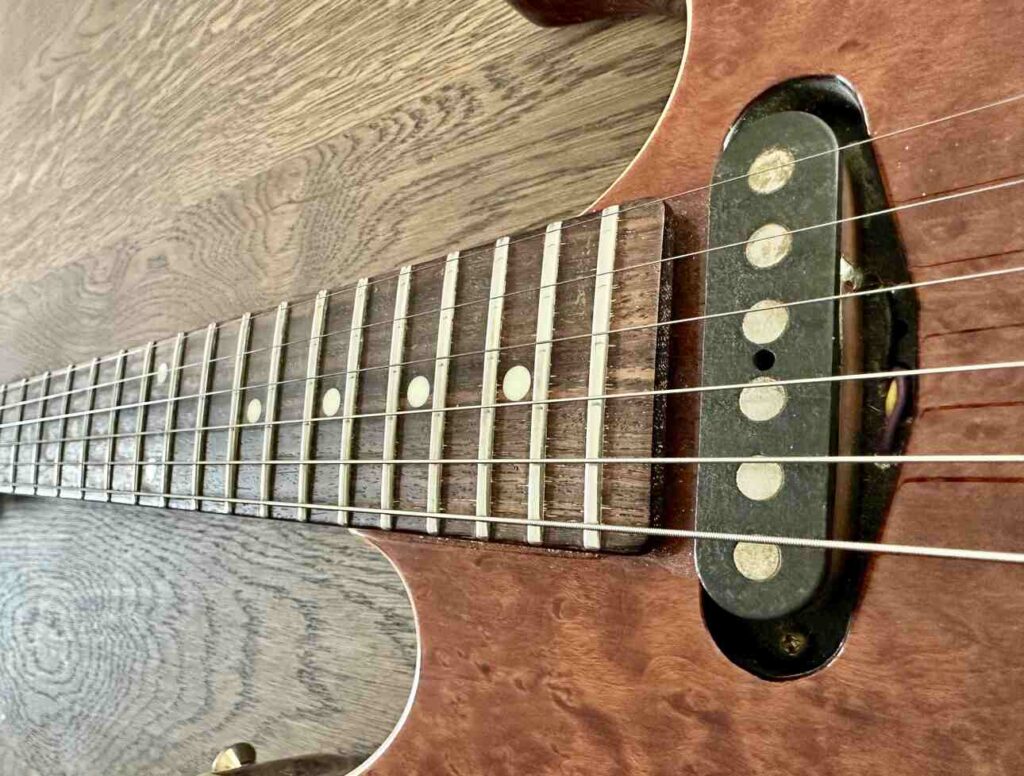
24 Fret Neck
- Full Range: Two full octaves per string, a dream for soloists and shredders;
- Tone: The neck pickup is closer to the bridge, which can lead to a brighter tone;
- Design: Often found on modern or shredder-style guitars.
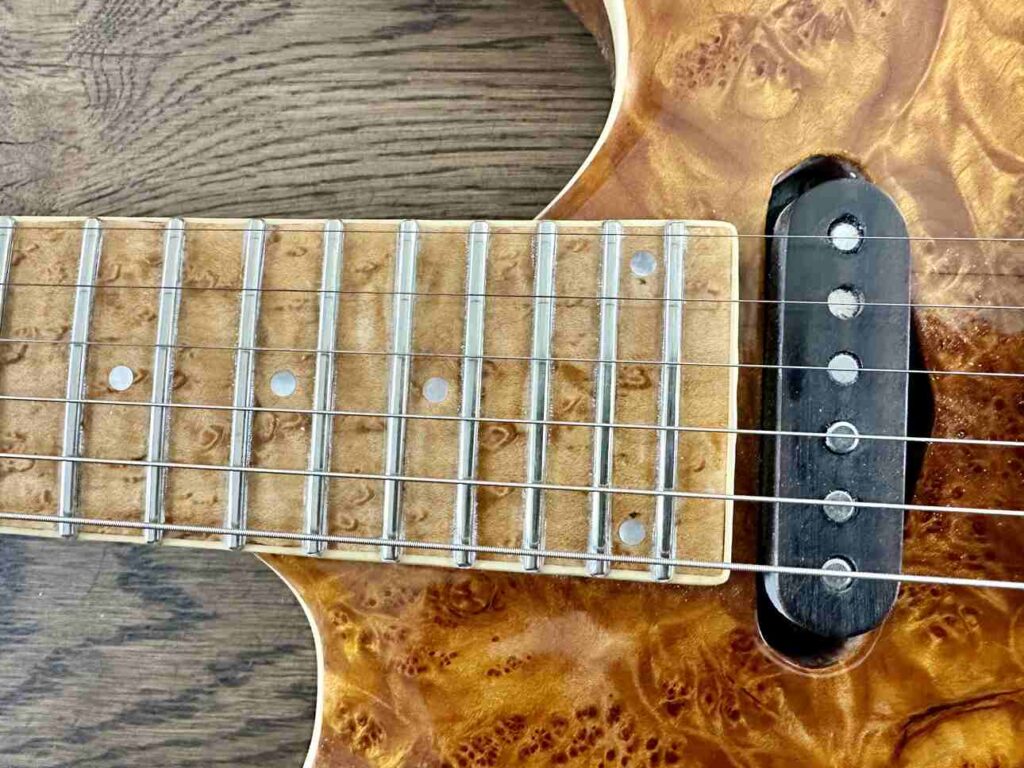
What to Watch Out For:
- Pickup Placement: More frets can change the position of the neck pickup, affecting tone;
- Neck Pocket: Ensure the new neck fits the body’s neck pocket, regardless of fret count;
- Scale Length: Keep it consistent with your guitar’s design to avoid intonation issues;
- Playability: Consider how the number of frets affects your playing style and comfort.
Choosing between 21, 22, or 24 frets isn’t just about the number—it’s about how it shapes your sound and playing experience.
Can You Replace a 22-Fret Neck With a 24-Fret Neck?
Swapping out a 22-fret guitar neck for a 24-fret one? Sure thing, but let’s break down what you’ve got to keep in mind.
- Scale Length: Keep it the same to stay in tune. Some 24-fret necks are ready to go as a swap for 22-fret models;
- Neck Pocket Fit: The new kid on the block has to snugly fit where the old neck used to live. You might need to tweak things a bit if it’s not a perfect match;
- Bridge Placement: The bridge has to be in the right spot to keep the scale length accurate. You’re golden if the new neck just adds frets without moving the bridge;
- Pickup Placement: More frets can mean your neck pickup might move. Since it’s usually at a spot that makes your guitar sing, a shift could change your sound;
- Overall Balance: A new neck might make your guitar top-heavy. It’s like putting on a heavy backpack—it could throw you off a bit;
- Fret Access: With a 24-fret neck, those high notes are easier to hit, thanks to deeper cutaways.
Thinking about doing the switcheroo? Chat with a luthier.
Materials Used in Neck Construction
Guitar necks are like the spine of your instrument, and they’re usually crafted out of trusty wood. Two prominent players in the neck wood league are maple and mahogany:
- Maple: This one’s the life of the party, bringing a bright vibe and a sustain that just won’t quit. It’s a common pick for bolt-on necks, making those notes pop;
- Mahogany: Think of this as the wise old oak of guitar woods. It’s got a weight to it and dishes out those deep, warm tones. You’ll often find mahogany hanging out on set-neck guitars, adding a bit of gravitas to your sound.
Getting to know these woods is like understanding the ingredients in your favorite dish – it can clue you in on why your guitar tastes… I mean, it sounds the way it does.
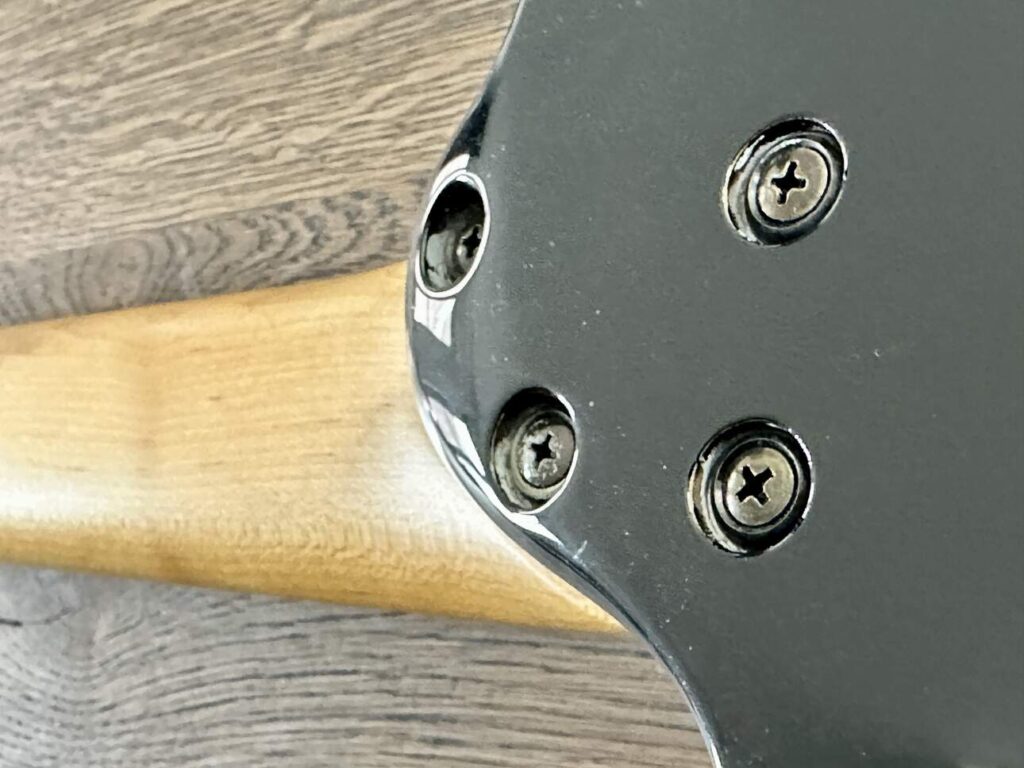
The Impact of Neck Changes on Playability
Scale Length Considerations
The scale length of a guitar neck is all about the stretch from the nut to the bridge saddle. This stretch significantly affects how tight your strings feel and the kind of sound they’ll make.
If you’re swapping necks, you’ve got to keep the scale length in mind. It’s like swapping out shoes; you want to make sure they fit just right.
For instance, take a Stratocaster neck, which typically measures 25.5 inches (64.77 centimeters). It’s the long jump champion of the guitar world.
On the flip side, a Gibson Les Paul neck goes for a cozy 24.75 inches (62.87 centimeters), making for a slightly shorter hop. So when you’re neck shopping, get the scale length right, and you’ll be rocking comfortably.
Fretboard Radius Effects
If your fretboard radius is too curvy or flat, it changes your playing experience. It’s the arch across your guitar’s fretboard, and it matters more than you might think.
If you’re thinking about slapping on a new neck, remember it might come with a new radius, and that will feel different under your fingers.
Some players are real Goldilocks about their fretboard curve. If that’s you, make sure the new neck’s radius is just right.
You don’t want to go from cruising on a vintage Fender’s 7.25-inch curve to a flatter Gibson 12-inch without being ready for the switch.
Here’s the deal with typical radii:
- 7.25-inch radius: That’s your classic Fender bend, like a comfy old sofa;
- 9.5 to 10-inch radius: The modern Fender standard, like a new office chair that fits just right;
- 12-inch radius: Gibson’s go-to, like a big flat desk – plenty of space to work with.
So when you’re neck hunting, think about how much curve you like and stick to it.
Neck Weight and Balance
The weight and balance of a guitar neck set the stage for how it feels. A neck that’s too heavy or too light can throw off your guitar’s equilibrium, making it a hassle to play.
When hunting for a new neck, think about the heft and how it sits with your guitar. You’re looking for that zone where everything feels just right.
If your fretboard radius is too curvy or flat,
it changes your playing experience
Common Pitfalls and Troubleshooting
Adjusting the Truss Rod
The truss rod in your guitar neck keeps everything straight, allowing tweaks to get the perfect neck position. If you’re popping in a new neck or just tuning up, dialing the truss rod is key to avoiding a wonky, warped neck.
Here’s how you give that truss rod the right twist:
1. Loosen the strings: Think of it like taking a deep breath before lifting something heavy. It gives the neck a break and sets you up for a smoother adjustment;
2. Find the truss rod nut: It’s either at the headstock or the neck’s base. If you can’t find it, peek into The Electric Guitar Handbook for clues;
3. Tweak time: Go counter-clockwise if your neck needs more curve. Too much belly? Clockwise will straighten it out. It’s a gentle nudge, not an all-out turn. Check the neck after each tiny twist to keep things just right.
Take it easy, and you’ll keep your guitar’s neck in prime shape.
Dealing with Fret Buzz
Fret buzz can sneak in when you swap necks. But don’t fret; you can kick it out with a few fixes.
- Raise the stakes: Crank up the string height at the bridge or the nut. Give those strings some room to ring out;
- Fret patrol: Got a fret sticking out like a sore thumb? That’s your buzz culprit right there. You might need to file it down to size or let a pro even things out with a setup;
- Neck check: A neck that’s too straight will make your strings buzz. Give that truss rod a tweak to arch the neck just a smidge, and you’ll be back to smooth strumming.
So, if you’re hearing more buzz than a beehive, take a gander at the action, the frets, and the neck relief. A little detective work, and you’ll have your guitar purring like a kitten in no time.
Ensuring Proper Intonation
Getting the intonation spot on is essential. Especially when you’re rocking an interchangeable neck, you want to make sure your guitar isn’t leading you off-key.
- First thing’s first: Tune up those strings. It’s like setting the starting blocks before a race;
- 12th fret detective work: Pluck the open string, then the same string at the 12th fret. They should be singing the same note an octave apart. If they’re out of sync, it’s time to roll up your sleeves;
- Bridge saddle shuffle: If that 12th fret note is coming in hot (sharp), you gotta give the saddle a pushback. If it’s dragging its feet (flat), nudge it forward. It’s a little dance until both notes are twins.
Keep these tips in mind, and you’ll keep your guitar’s intonation as straight as an arrow.
Frequently Asked Questions
How do I replace the neck on my electric guitar?
When you want to replace the neck on your electric guitar, you gotta take off the strings and unscrew the bolts holding the neck to the body. Gently slide out the old neck and slip in the new one, making sure the holes for the screws line up. Screw it back in snugly, but don’t go Hulk on it – you don’t want to crack anything. Restring, tune-up, and you’re ready to rock.
What should I consider when looking for a budget-friendly guitar neck?
Look at the wood type, what the fretboard’s made of, and how many frets it’s sporting. Compatibility with your guitar body is key; don’t forget to snoop around for reviews.
Can a Fender Strat neck fit on any guitar body?
It’s not a wild idea, but it’s not always a walk in the park, either. Some bodies might need a tweak or two to make it fit. Do your homework first to avoid any Franken-guitar fiascos.
What are the differences between various brands of guitar necks, like Ibanez and Fender?
Comparing guitar necks from brands like Ibanez and Fender is like comparing apples and oranges. Ibanez’s necks are slim and quick, perfect for shredders. Fender necks are more like a comfy couch – rounded and ready for anything. They also use different woods, so the sound and feel can be as different as night and day.
How do I ensure proper fit when attaching a new neck to my guitar body?
To make sure your new neck and guitar body are a match made in heaven:
- Measure the neck pocket and the neck like you’re tailoring a suit. They should fit without having to force it;
- Line up the bolt holes. You should do some detective work if they’re playing hide and seek;
- Take your time putting it all together. Rushing could end up in a guitar tragedy.

